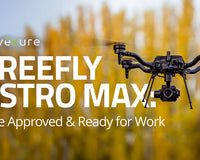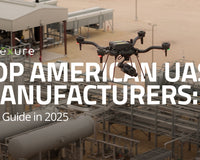Misconceptions, speculations, and even rumors have been in circulation regarding what the Blue UAS (also known as Blue sUAS) program advocates for in its entirety.
Over the last two years, this has been among the main topics of interest in the U.S drone industry.
So, has the Blue UAS program influenced the drone ecosystem in the U.S positively or negatively? We'll find this out shortly, but first, let's dissect the program's contents.
What is Blue UAS?
In August 2020, the Department of Defense (DoD) released a list of five drones recommended for use by the U.S. government after security concerns over Chinese-manufactured UAS grew.
These five were an improvement on the five Short Range Reconnaissance (SRR) UAVs.
You're probably wondering what criterion they used to arrive at this decision. That's where the Defense Innovation Unit (DIU) comes in.
The DIU is a department under the DoD, and it was actively involved in the rigorous research and tests that spearheaded the program's pilot phase. The Blue UAS pilot project's name later evolved to Blue UAS 1.0 after DIU unveiled the second phase.
In October 2021, the DoD released the second list known as Blue UAS 2.0. The list's contents were slightly different from Blue UAS 1.0 (more on that in a bit).
The Lifecycle of Blue UAS
Five vital steps are involved in clearing a drone for federal usage.
They include:
1. Blue UAS Framework
Component and software development takes place during this step. The DIU provides valuable input to the listed companies to ensure the end product meets their criteria.
2. Foundry
The Blue UAS foundry is DIU's prototyping process. Design teams experiment with various ideas from the federal user's "suggestion box" to create a final product that caters to their unique needs.
3. On-Ramp
It's a more effective drone approval process. The streamlined vetting process represents the "ready for take-off" phase as it paves the way for the availability of robust and secure commercial UAS for government procurement.
4. Blue UAS Cleared List
It contains a list of NDAA-compliant drones certified for use during military operations.
The best part about the list is that it's not fixed, as it's regularly updated. The listed drones help the government save on costs and time by providing regularly updated acquisition guidelines.
5. Hub
Blue UAS hub houses all the relevant information on the program for the relevant stakeholders to use as reference.
Unpopular opinion- the Blue UAS program is a pathfinder for new prototyping, acquisition, and vetting processes. The program's purpose is far from wanting to gate-keep the market share but aims to ease the acquisition process for federal partners who require their sUAS to:
- Be compliant with the law.
- Be thoroughly cyber-assessed to spot cyber vulnerabilities.
- Have appropriate administrative documentation.
So, what's the difference between these two Cleared Lists? We'll figure this out in the following category.
Blue UAS 1.0 vs. Blue UAS 2.0
The main difference is that the program's first round only listed particular drones, whereas the Blue UAS 2.0 only listed vendors approved to sell to federal agencies.
The five drones that made it to the cleared list in the first round include:
- Altavian M440 Ion
- Parrot ANAFI USA
- Skydio X2-D
- Teal Golden Eagle
- Vantage Robotics Vesper
The eleven Blue UAS 2.0 vendors that made it to the cleared list include:
- Ascent AeroSystems
- BlueHalo LLC
- Easy Aerial Inc.
- FlightWave Aerospace Systems Corporation
- Freefly Systems East
- Harris Aerial
- Inspired Flight Technologies Inc.
- senseFly Inc
- Skydio, Inc.
- Vision Aerial
The increasing relevance of sUAS on the battlefield fueled the development of these new prototyping processes.
Blue sUAS 1.0 includes drones that have been put through many testing programs to acquire drones that are suited for their unique needs easier for the DoD.
The same applies to Blue sUAS 2.0, only it's a new, improved list that broadens the DoD's supplier spectrum. The ripple effects of an increased drone variety include lowered acquisition costs and increased secondary capabilities.
Essentially, the Blue UAS program's target market is the DoD, but its butterfly effect spreads to other government agencies.
So, where does that leave the non-listed vendors?
Blue UAS: The Future of DJI and Non-listed Drone Vendors
The ban on DJI drones in 2017 brought to light the state of the U.S drone industry, which was lagging in terms of price, capability, and market share. That ban greatly affected operations in the army, Pentagon, and U.S. Department of the Interior.
Sourcing for alternatives was no easy feat, and DIU leveraged that opportunity to avail National Defense Authorization Act (NDAA) compliant drones for federal agencies.
The prohibition of DJI drones for federal use occurred after the NDAA's classified report expressed cybersecurity concerns. However, the manufacturer argued against their product having any cyber vulnerabilities.
So, will the DJI drones ever get to the “cleared list?” Probably not.
Despite DJI's bleak future of approval for U.S government operations, DJI fanatics can breathe a small sigh of relief since the ban only applies to federal agencies, and not the state or local public safety agencies.
It's worth noting that, out of the five Blue UAS listed drones, four were from U.S.-based manufacturers. The Teal Golden Eagle and Vantage Robotics Vesper use a U.S. based camera module created by the army during their project: the DIU-SRR program.
The camera module is called FLIR Hadron, which has a dual sensor. The program aimed at stimulating the U.S. drone supply chain for local consumerism.
The DoD's efforts to promote local drone production aren't to imply that the government is not open to foreign inclusivity, as Parrot's parent company is in France.
The main point is that local and foreign non-listed vendors need not worry about their status.
Their non-listed status is not a deterrent factor, as any vendor can still sell drones to the government. It's only that the procurement won't be as seamless, whereas other entities prefer using drones from the Blue UAS Cleared List.
The good news is that the DoD confirmed that work is in progress to develop a more inclusive system for more vendors to get a share of the big pie.
Non-listed vendors have also put in suggestions to fast-track this process. For instance, some have suggested self-funding the on-ramping process.
DIU project managers seem receptive to the idea, but only time will tell.
What's Best for Your Drone Program?
Hopefully, the article has provided you with insights into the Blue UAS program.
It’s one in a short series of articles we plan to produce about the program. Feel free to share the article with a friend who has been seeking clarity.
We at Advexure would love to hear your thoughts on the approved DoD drones. We’re also here to help you get the right UAS to add to your fleet.
If you're a DJI fanatic in law enforcement and are still wondering whether the drones are lawfully fit for use in your industry. Yes, certainly! Do you want to make the switch to Blue UAS? We can help with that as well. We’re drone-agnostic, so you don’t need to worry about us picking based off of bias.
Also, if you are looking to learn more about drone programs, here’s an article that will help you figure that out:
Here's Why You Need to Start a Drone Program for Your Public Safety Agency
When you're ready to get started, just open the chat box or click here. We’ll help you to not only start a program, but integrate new technology into that fits your specific use-cases.










